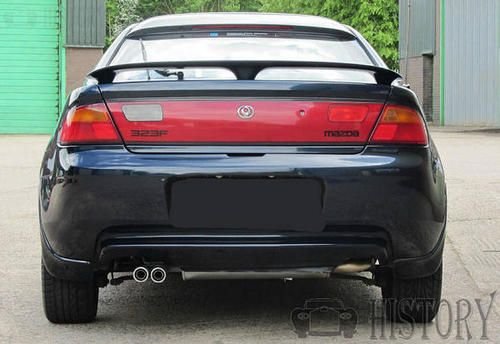Mazda 323 Familia Seventh generation
 |
|
| Also called | Mazda 323 Mazda Allegro Mazda Artis Mazda Protegé Mazda Étude |
|---|---|
| Production | 1994–1998, 1995–1999 in Colombia, 1996–2000 in the Philippines |
| Assembly | Hiroshima, Japan Hofu, Japan Bogotá, Colombia Pretoria, South Africa, Parañaque, Philippines (Columbian Autocar Corporation) Rayong, Thailand Willowvale, Zimbabwe (WMMI) |
| Body style | 3-door hatchback (Neo) 4-door sedan (Protegé/Familia) 4-door hardtop sedan (Lantis) 5-door hatchback (Lantis/Astina) |
| Layout | FF layout |
| Engine | 1.3 L B3 I4 1.5 L Z5 I4 1.5 L B5 I4 1.8 L BP I4 1.7 L 4EE1 I4 Diesel |
| Transmission | 4-speed F-4EAT automatic 5-speed manual |
| Wheelbase | Hatchback: 2,450 mm (96 in) 1997–98 Sedan: 2,607 mm (102.6 in) |
| Length | Hatchback: 4,155 mm (163.6 in) 1997–98 Sedan: 4,440 mm (175 in) 1995–96 Sedan: 4,435 mm (174.6 in) |
| Width | 1997–98 Sedan: 1,710 mm (67 in) 1995–96 Sedan: 1,694 mm (66.7 in) Hatchback: 1,670 mm (66 in) |
| Height | 1995–96 ES Sedan: 1,381 mm (54.4 in) 1997–98 Sedan: 1,420 mm (56 in) 1995–96 Sedan: 1,386 mm (54.6 in) Hatchback: 1,380 mm (54 in) |
| Related | Mazda 323F/Lantis/Allegro Ford Laser Ford Escort Mercury Tracer |
| Designer(s) | Yujiro Daikoku (1992) |
An unusual JDM model appeared in 1994, with the cancellation of the 1985-generation station wagon. The Mazda Familia Van offered after this year was a rebadged Nissan Wingroad/Sunny California, which was essentially the station wagon version of the Nissan Sunny N14.
This generation of Familia grew considerably, with the four-door sedan's wheelbase only a few millimetres short of the then-current Toyota Camry, a mid-size car.
The rare North American ES model came with the Miata's 1.8-liter twin-cam engine (though the internals were not the same), 4-wheel disc brakes, and dual stabilizer bars. The same car went on sale in Australia in second half of 1994. with fully featured BP-ZE engine. The Protegé became a "compact car" for the 1995 model year in North America.
The Familia/Protegé/323 was facelifted in 1996, with a newer style.

- Models
- 4-door sedan (called the Protegé in North America, 323S in Europe, 323-Protegé in Australia and Étude in South Africa)
- 3-door hatchback (Familia Neo in Japan, 323C and 323P (323P being a hatchback version of 323S) in Europe, Laser Lynx as a Ford)
- A tall wagon on Nissan-basis, called the Familia Van, was also available in Japan.
Familia Neo/323C
The Familia Neo started production for the Japanese domestic market in 1994, and was also sold as the 323C in Europe and the 323 Neo in Canada. Ford released a rebadged version which was mechanically the same although different bumpers, headlights and bonnet were fitted, badged as the Ford Laser Lynx in Japan and Australia. This model was only available as the Ford Laser-Lynx in the Australian market, as Mazda already had the 323 Astina Hatch filling the gap for a hatchback in the Mazda range. Oddly enough to contradict this, Mazda Australia also offered two 323 sedans, the Astina/Lantis hardtop and the 323 Protegé until production of both models ceased in 1998.
This was released new in New Zealand as the Mazda Familia Neo. It featured a rear hatch with a divided glass, much like the Honda CR-X. Aesthetically the Familia Neo was very close in looks to a Mazda Lantis/323F and equated to a three-door version and also shared the Lantis suspension. The top specced Mazda Neo was fitted with a DOHC 1,800 cc BP engine which produced around 112 PS (82 kW), and this was the same engine fitted to the base model Mazda Lantis. It was also sold for a single year (1995) in Canada as 323 Neo GS. In Europe it was named Mazda 323C (for coupé) and it was equipped with 1.3 L SOHC (75 HP), 1.5 L DOHC 16V (88 HP), and 1.8 L DOHC 16V (112 HP) engine.
Lantis/Astina/323F
A five-door hatchback and four-door sedan, both featuring pillarless doors and distinct sheetmetal from other 323s, was sold in Japan as the Mazda Lantis, in Australia and South Africa as the Mazda 323 Astina, in Colombia as the Mazda Allegro and in Europe as the Mazda 323F.
They were built on platforms distinct from the other 323s. The bodyshape was designed by former Porsche designers. The Lantis was on the CB, a minor update of the CA that underpinned the luxury Mazda Xedos 6 and Eunos 500. The European 323F was designated BA, but was actually almost identical to the CB, and had little to do with other B platforms. These models were sold with the 1.5 L 1.6L and 1.8 L engines seen in the rest of the 323 range, as well as a 2.0 L V6 shared with the Eunos 500.

- Engines
- 1994–1998 – 1.5 L (1,500 cc) Z5, FI, 16-valve DOHC, 89 hp (66 kW; 90 PS) / 97 lb·ft (132 N·m)
- 1994 - 1998 1.6 L B6D
- 1994–1996 – 1.8 L (1,800 cc) B8, 114 hp (85 kW; 116 PS) / 115 lb·ft (156 N·m)
- 1994–1996 – 2.0 L (2,000 cc) KF V6, FI, 24-valve DOHC, 144 hp (107 kW; 146 PS) / 132 lb·ft (179 N·m)
- 1995–1999 – 1.3 L (1,300 cc) B3, 74 hp (55 kW; 75 PS) / 77 lb·ft (104 N·m)
- 1995–1999 – 1.8 L (1,800 cc) BP, FI, 16-valve DOHC, 131 hp (98 kW; 133 PS) / 118 lb·ft (160 N·m)
- 1995–1999 – 2.0 L (2,000 cc) RF, Diesel, 8-valve, 71 hp (53 kW; 72 PS) / 94 lb·ft (127 N·m)

